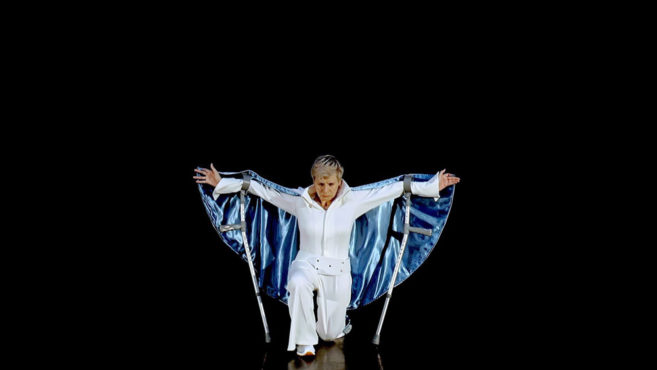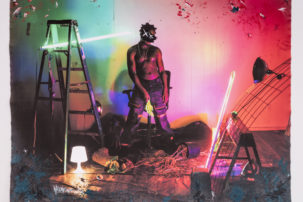As of June 2019, the tallest building in the 5,000-person town of Sackville, New Brunswick, is a 14-storey blueberry and cranberry freezer that locals refer to as “the Cube.” And one cloudless evening in August 2020, it was repurposed for a social-distancing-friendly public screening of video art. There, a crowd of approximately 250 people gathered in the glow of a projection screen nearly as tall as Niagara Falls.
The program centred queer artists, largely because the town had recently lost its lone queer-friendly bar and music venue, Thunder & Lightning, which closed in May due to the pandemic. Its closure is part of a distressing pattern, as several spaces once vital to the artistic life of Sackville have disappeared in the last five years, including George’s Fabulous Roadhouse, the former United Church and the Sackville Music Hall.
Thus, a grim irony hovered over the event: the town’s newest and most substantive infrastructural project is an automated freezer. The dream of converting it into a screen for an evening’s entertainment was delimited by a real erosion of the town’s cultural foundations.
There have been better days, as amplified via a program featuring many artists with ties to Sackville. The first selection, Colin Campbell’s Sackville, I’m Yours (1972), is a relatively famous meditation on fame, or so I later learned. Lacking any familiarity with the work, I couldn’t help but view it through the prism of the pandemic. Campbell’s talking-head framing, though from the early 1970s, appeared to formally anticipate conversation in our quarantine future, detached and claustrophobic. I write “appeared” because I couldn’t hear most of what Campbell’s Art Star character was saying: I am hard of hearing and missed too many of his seemingly amused and amusing reflections on being a (queer) artist in a university town. As I found out later, the poor sound quality stemmed from the fact that Campbell had recorded the work using the Mount Allison University football team’s video equipment.
The audio potential of the venue was best realized through four musicbased works that followed the strong second selection, Michèle Pearson Clarke’s Black Men and Me (2006). Two of these works were music videos, Daniel Barrow’s A Miracle (2003) and Jeremy Dutcher’s Mehcinut (2019), and a third was a kind of music-video parody, Benny Nemerofsky Ramsay’s I am a Boyband (2002). Notwithstanding the cinematographic sophistication of these works, I wanted more from the pairing of art and site, something more after a spring and summer sans art openings, public talks, artists in residence and weekly gallery BBQs. Diane Borsato and Rita McKeough’s Big Rock Quiet (2018) pulled me out of my despair for four precious minutes, though, and at sublime scale. With her back to Banff’s Mount Rundle in this video, McKeough ripped a drum solo that might still be echoing off the Public Works building across from the Cube.
The other musical work that took full advantage of the scale, dimensions and acoustics of the venue was Lido Pimienta’s Miss Colombia Medley (2020). Pimienta had been booked to perform in person at Sappyfest (at which, full disclosure, I am a board member) but had to do a 27-minute projection concert set instead. The sustained close-up framing, with Pimienta’s eyes holding everything in place, momentarily moved the Cube from novelty to necessity, albeit bittersweetly.
If the Cube is ever to become a permanent part of a new way of performing in Sackville, it will require more than the determination and ingenuity of the co-presenting institutions that brought this event to fruition in less than two months. The limited planning timeline likely accounts for the choices that didn’t quite live up to the Cube’s promise. But that the event happened at all sets an inspiring precedent in times that continue to be described as “unprecedented.”
This review originally appeared in print with the title “The Cube Show.”

 A recorded performance of the band
Wares projected in “The Cube Show,”
August 2020. Photo: Mathieu Léger.
A recorded performance of the band
Wares projected in “The Cube Show,”
August 2020. Photo: Mathieu Léger.






